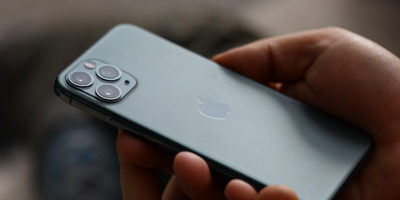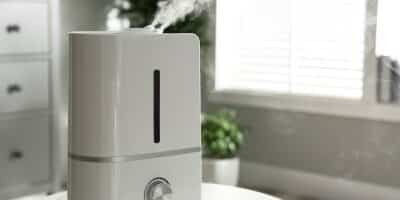
Covering all the bases of your baby’s needs can leave you as parents with unanswered questions—including the ideal humidity level for your baby’s room.
We all know that a full night’s sleep is crucial for our overall health, but you may not realize just how vital humidity can be in determining the quality of our sleep.
Because our bodies use some of their most intense recovery processes while we sleep, disruptions of any kind can prove problematic. Exposure to harmful humidity levels can prevent us from reaping the full benefits of a night’s rest.
So how do you protect your little ones from these complications? The answer is more straightforward than you think. It’s just a matter of maintaining the correct humidity levels in your home and nursery.
The ideal humidity level for a baby’s room is between 30% and 50%. The EPA recommends this indoor humidity range, and they state that it should never exceed 60%. Read on as we dive a little deeper into exactly how to maintain these conditions.
How to Monitor Humidity Levels in Your Nursery

Considering we can’t detect humidity levels on our own, we recommend investing in a hygrometer. A hygrometer is a device designed to gauge humidity levels, and it can aid you in determining what solutions are necessary to create a comfortable sleeping environment for your baby. Please read our extensive guide, which will help you find the right hygrometer for your home.
If your nursery is too humid, consider using a dehumidifier or even running your air conditioning unit. Running a dehumidifier or your air conditioning can lower the humidity and reduce the dampness of the air, preventing the unnecessary spread of dust mites, mold, and other pests that might trigger allergic reactions in your child.
Conversely, if the room is too dry, you can use a humidifier to increase the humidity in your home and improve the conditions of an overly dry room.
Does Dry Air Affect Your Baby’s Health?
High humidity can easily disrupt your child’s sleep, but low humidity can prove equally detrimental. Spells of low humidity often occur in the wintertime. When the temperature decreases outside, the relative humidity naturally starts to drop. We only make the problem worse when we turn up our heating units to stay warm, eliminating more moisture from the air. This indoor climate shift can lead to many unwelcome symptoms and signs that you need to use a humidifier, from dry skin to sinus irritation and throat conditions, inevitably preventing quality sleep.
To combat dry air, consider purchasing a humidifier to increase moisture in the home and help maintain an ideal humidity level for your baby’s room.
Should You Have a Humidifier in Your Baby’s Room?
It might seem best only to use humidifiers when absolutely necessary, but they can be a great help in improving your child’s sleeping habits during the colder months of the year.
No one sleeps comfortably with a stuffy nose or a scratchy throat, and this is especially true for our little ones. Crying babies are not sleeping babies, and symptoms resulting from dry indoor air can distress and disrupt their much-needed rest.
A humidifier can help relieve those symptoms and, as a result, give your little one a more comfortable, restful sleep.
Top Tips When Using a Humidifier for Your Baby
When choosing a humidifier for your child’s room, the options can be overwhelming. Here are a few key elements to help you decide what’s best for you and your baby.

Type of Humidifier
While several affordable and high-quality large humidifier models are available, ultrasonic models are the current gold standard for humidifiers. These humidifiers are easy to operate and offer a variety of settings to help you create the perfect atmosphere for your baby’s nursery. They’re extremely quiet, which is perfect for light-sleeping little ones, and they also produce the faintest white noise that pediatricians believe can improve sleep.
Safety
Humidifiers can help improve ideal indoor air conditions for you and your child, but their usefulness is dependent on how well you maintain them. Here are some things to consider in combination with the instructions in the user manual.
Routine Cleaning
The moisture that humidifiers emit can create an ideal environment for mold growth. To avoid the possibility of your child breathing in such toxins, it’s crucial to regularly disassemble and thoroughly clean every part of the device with a diluted vinegar solution to prevent mold and bacteria build-up. You should also change the water before each use.
Avoiding Hazards
While the warm mist setting on Ultrasonic models is appealing, sticking with cool mist is often safer. Warm water within the humidifier could pose a potential risk for children who could potentially touch or spill it. Likewise, keeping the humidifier and any attached cords away from children is necessary to prevent any accidents.
Placing the Device in a Safe Position
Ideally, you want to avoid contact between your child and the mist the humidifier produces. Keep a safe distance by placing the device at least six feet away from your child’s bed. This distance prevents any respiratory complications and discomfort that excess moisture can cause while maintaining a humidity level that aids in quality sleep.
To avoid potential water damage and to ensure a wide distribution around the nursery, be sure to face the mist nozzle toward the center of the room and away from any walls, curtains, or furniture. Likewise, consider placing the unit at least a few feet from the floor on top of a waterproof tray to allow the mist to reach more of the room and prevent moisture build-up on the ground. Please read our guide for more tips on positioning a humidifier in your home.
What Is the Best Room Temperature for a Baby?
Just as excessively low or high humidity can affect our sleep, a room that’s too cold or too warm can also make rest difficult. As a baby’s body is overly sensitive to its environment, they are especially susceptible to temperature variations.
Parents might assume that they should keep infants bundled and as warm as possible, but infants require a fixed temperature that isn’t too hot or cold. If your baby becomes too hot, the risk of Sudden Infant Death Syndrome (SIDS) increases.
While the ideal sleeping temperature for adults can vary, the medical consensus is that the ideal room temperature should be between 68 and 72 degrees Fahrenheit or 20 to 22.2 degrees Celsius for babies and toddlers.
Final Thoughts
Comfortable babies are happy babies—and happy babies sleep better. To achieve the ideal humidity level for your baby’s room, consider purchasing a humidifier to maintain stable conditions, especially in the winter months. And remember, resist your urge to bundle that baby up! Overheating disrupts both sleep and health. Stick to lighter clothing and blankets and monitor your nursery with a hygrometer to ensure your baby is in a comfortable and healthy environment.
The correct combination of these devices and tips might vary from home to home. Still, it’s essential to consider your family’s needs year-round to maintain a consistent and safe environment for you and your children.




